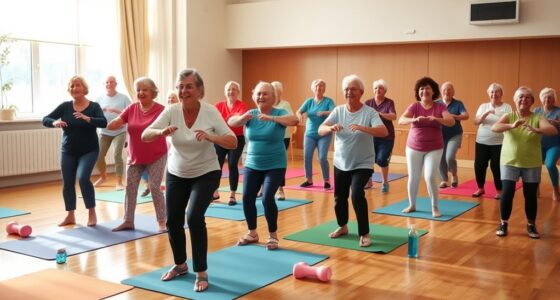Engaging in senior exercise programs can leave you feeling amazing both physically and emotionally. Incorporating energizing warm-ups, strength-building exercises, and effective stretching enhances your flexibility and balance. It’s essential to modify workouts for comfort and safety, ensuring you listen to your body’s signals. Breathing techniques can further promote relaxation and improve your overall experience. Consistency is key to achieving long-term benefits, and you’ll find that community support can make your journey even more rewarding. Explore how you can get started!
Key Takeaways
- Engaging in regular strength and balance exercises enhances mobility, making daily tasks easier and fostering independence.
- Participation in senior exercise programs promotes social interaction, reducing feelings of isolation and boosting emotional well-being.
- Energizing warm-up techniques, like marching in place, prepare your body for exercise and elevate overall performance.
- Daily stretching improves flexibility and range of motion, contributing to better overall quality of life and injury prevention.
- Consistent exercise routines stimulate cognitive function, alleviating symptoms of brain fog and enhancing memory retention.
The Importance of Senior Exercise Programs

When it comes to maintaining health in later years, senior exercise programs play an indispensable role. These programs, like Go4Life, offer tailored routines that include strength exercises and balance exercises, which are crucial for enhancing your physical fitness and overall well-being. Foods rich in omega-3 fatty acids support cognitive function, which is an important aspect of overall health for seniors. Additionally, understanding the importance of long-term financial planning for assisted living needs can help ensure that resources are available to support ongoing health and wellness initiatives. Engaging in regular physical activity can also help mitigate symptoms of brain fog that may affect cognitive function in seniors. Regular participation in exercise can also improve overall well-being, such as enhanced mood and lower stress levels.
Working with a personal trainer can help you stay motivated and guarantee you’re performing exercises correctly to maximize benefits. Regular participation reduces the risk of chronic diseases, boosts mental health, and improves mobility and independence.
Plus, engaging in these programs fosters social interaction, creating a supportive community that combats feelings of isolation. By committing to senior exercise programs, you’ll not only improve your strength and balance but also enhance your cognitive function and memory retention. Additionally, participating in regular physical activity can help develop resilience against stress and anxiety, promoting a healthier mindset as you age.
Energizing Warm-Up Techniques
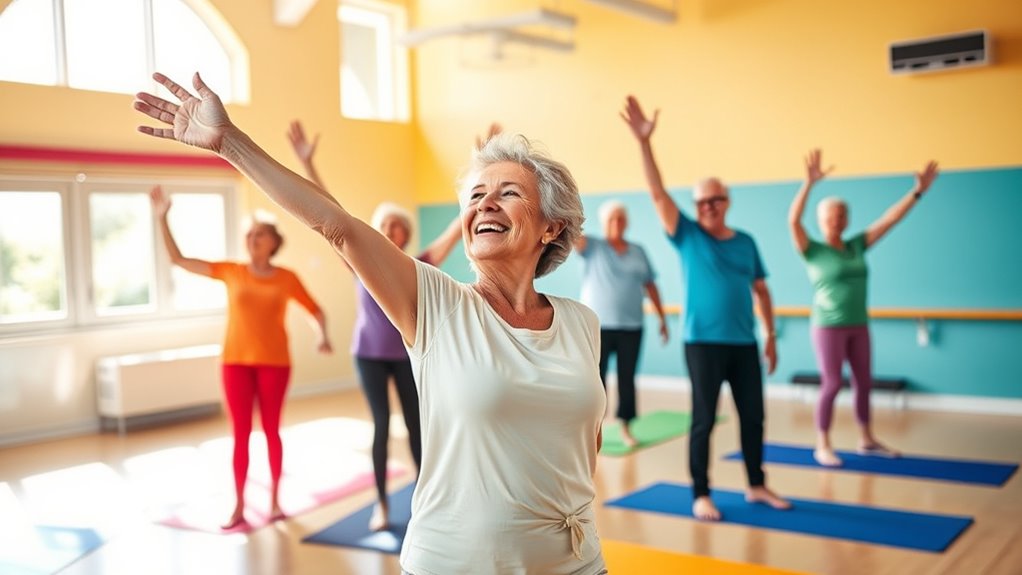
To get the most out of your workout, starting with energizing warm-up techniques is essential.
Begin by marching in place to elevate your heart rate and prepare your muscles for exercise. This simple movement gets your blood flowing and primes your body. Engaging in these techniques can also help align your energy with desired outcomes for a more fulfilling workout experience.
Next, incorporate step touches while engaging your arms to loosen muscles and enhance flexibility. If you prefer a seated option, use a sturdy chair for seated quad warm-ups and calf stretches, targeting specific muscle groups effectively. Regular exercise is not only beneficial for physical health but also helps in reducing obesity and related health issues. Engaging in physical activity can also contribute to energy efficiency by improving metabolism and reducing fatigue. Additionally, maintaining a regular exercise routine can support RMDs for those managing retirement accounts, ensuring you stay active and healthy as you age.
Remember to maintain proper posture—feet shoulder-width apart and shoulders relaxed—to optimize your alignment.
Consistently practicing these warm-up techniques can improve your performance during strength exercises and boost your overall fitness levels, helping you feel amazing as you work out! Additionally, establishing consistent routines can enhance your overall well-being as you engage in physical activities.
Strength Building With Simple Exercises

Strength building is essential for seniors looking to enhance their overall fitness and maintain independence.
You can easily incorporate simple exercises into your routine that require minimal equipment, like water bottles for weights. Start with arm curls and overhead arm raises, ensuring you keep your elbows tight to your sides.
Chair stands are another effective exercise, promoting strength and stability. Don’t forget about leg raises; they’re great for improving muscle tone and balance.
Aim for 10 repetitions of each exercise, focusing on proper form to prevent injury. As you consistently engage in strength building activities, you’ll notice improvements in mobility, a reduced risk of falls, and a better quality of life.
Stay committed, and you’ll feel amazing!
Focusing on Lower Body Strength and Balance
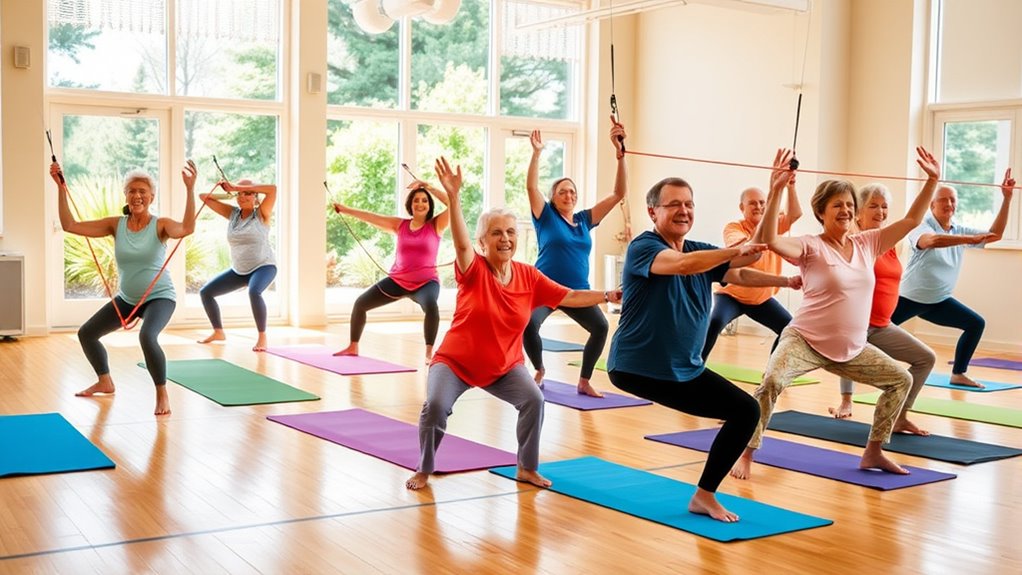
Focusing on lower body strength and balance is essential for maintaining independence as you age. Engaging in exercises like side leg raises and back leg raises can greatly strengthen your hip and leg muscles, improving your overall stability. Additionally, incorporating scratching posts can help redirect any unwanted behaviors, ensuring a safer environment during your workouts. Regular physical activity can also reduce anxiety and enhance overall well-being. Engaging in these exercises can foster lifelong learning about your body’s capabilities and limitations. A well-balanced diet, including meals rich in protein, like a Turkey Bean and Tomato Zoodle Bowl, can support your physical activities.
Make sure to maintain good posture—keep your legs straight and engage your core to maximize effectiveness. Incorporate balance exercises, such as chair stands, to enhance coordination and prevent falls, a common concern for seniors. Aim for lower body strength workouts at least twice a week to improve muscle mass. Also, listen to your body; encourage hydration and rest as needed.
If you need support, use your left hand on a sturdy surface to help maintain balance during these exercises. Additionally, consider how increased smartphone usage can facilitate engagement in fitness communities for support and motivation.
Effective Stretching for Flexibility
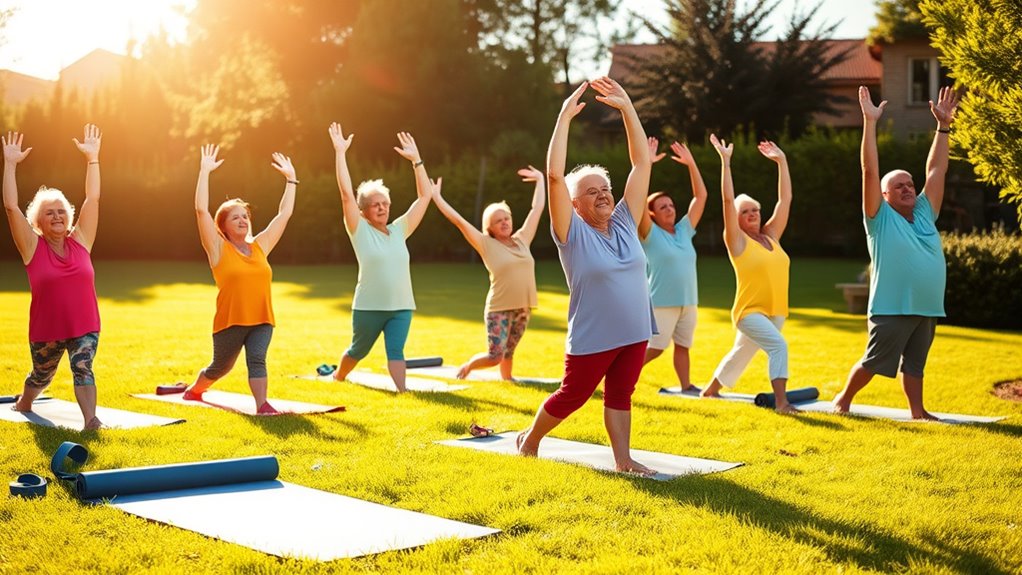
Daily stretching plays an essential role in maintaining your flexibility and keeping stiffness at bay. By using specific techniques, like holding stretches for 15 to 30 seconds, you can effectively enhance your range of motion. Additionally, incorporating effective techniques into your routine can further improve your overall well-being. It’s important to be aware of breast cancer symptoms, as early detection can significantly impact treatment outcomes. Engaging in personal growth techniques such as setting SMART goals can also help you stay motivated and committed to your fitness journey. To support your stretching routine, consider the benefits of regular exercise for seniors, which can enhance both physical health and mental well-being. Furthermore, establishing clear savings goals for your health-related expenses can ensure you remain financially prepared for future wellness needs. Let’s explore some effective stretches that can easily fit into your routine.
Importance of Daily Stretching
As you age, incorporating daily stretching into your routine can greatly enhance your flexibility and overall mobility. Stretching improves your range of motion, which is essential for maintaining independence. Additionally, improved air quality from using air purifiers can enhance your respiratory health during exercise.
By holding stretches for 15 to 30 seconds, you can relieve muscle tension and boost your physical performance over time. Consistent stretching decreases the risk of injuries by promoting muscle elasticity and joint health.
Plus, adding breathing techniques during your stretches enhances relaxation and effectiveness. Regularly targeting areas like your calves, shoulders, and triceps can lead to significant improvements in daily movements and overall quality of life.
Additionally, maintaining a clean indoor environment with air purifiers can further support your respiratory health during exercise. Embrace daily stretching, and you’ll feel the benefits in your strength and mobility.
Techniques for Effective Stretches
To enhance your flexibility effectively, you’ll want to employ a few key techniques during your stretching routine.
These methods will help you feel amazing and keep you moving freely:
- Hold each stretch for 15 to 30 seconds to improve flexibility and range of motion without pushing into pain.
- Stretch daily to greatly enhance your overall mobility, ensuring you maintain independence as you age.
- Use a towel during shoulder and triceps stretches to keep proper form and elbows close to your head.
- Incorporate breathing techniques to relax your muscles and make each stretch more effective.
Remember to balance your stretches on both sides and repeat them 3 to 5 times for the best results!
Modifications for Safety and Comfort

When it comes to exercise, listening to your body is essential for your safety and comfort.
Using a sturdy chair can provide the support you need, while adjusting your pace guarantees you stay within your limits.
Listening to Your Body
Listening to your body during exercise is essential for staying safe and comfortable. By tuning in to your physical sensations, you can prevent injuries and enjoy your workouts more fully.
Here are some important tips to keep in mind:
- Modify as Needed: If an exercise feels too tough, reduce repetitions or switch to an easier version.
- Stay Hydrated: Take hydration breaks and listen for your body’s signals to rest.
- Posture Matters: Maintain good posture and engage your core to alleviate discomfort.
- Know Your Limits: Always prioritize safety; adjust movements or use supports for stability.
Chair Use Benefits
Using a sturdy chair during exercise not only boosts your confidence but also enhances safety and comfort. A chair with arms provides stability, reducing fall risks and helping you feel secure while moving.
Modifications allow those with limited mobility to safely perform strength and balance exercises, like chair stands and dips, engaging your core and lower body effectively. Incorporating a chair into your workouts expands your range of motion for movements such as arm curls and overhead raises, letting you focus on form without overexerting yourself.
Plus, using a chair supports good posture, ensuring proper alignment and reducing strain on your joints. Seated stretches can also improve flexibility and target specific muscle groups, all while minimizing discomfort.
Exercise Pace Adaptation
Modifying your exercise pace is essential for guaranteeing both safety and comfort, especially as you adapt to different fitness levels.
Listen to your body, and don’t hesitate to make modifications. Here are some effective strategies:
- Adjust Intensity: Decrease weight or reps during strength exercises to maintain proper form and prevent discomfort.
- Seated Alternatives: Incorporate seated exercises like chair stands or arm curls for added safety if you have balance issues.
- Take Breaks: Allow frequent pauses for hydration and rest to avoid fatigue and listen to your body’s needs.
- Focus on Form: Emphasize good posture and core engagement to enhance stability and guarantee your comfort throughout each movement.
Breathing Techniques for Enhanced Relaxation
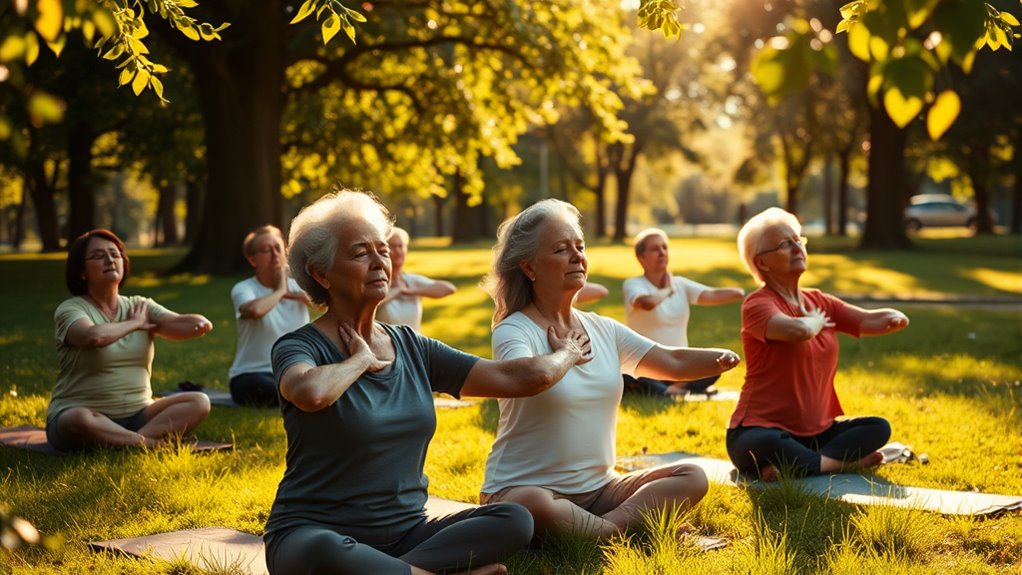
As you engage in your exercise routine, incorporating effective breathing techniques can greatly enhance your relaxation and overall performance.
Try deep breathing to activate your body’s relaxation response, reducing stress and anxiety during your workouts. Inhale slowly through your nose for a count of four, letting your abdomen expand, then exhale gently through your mouth for a count of six. This practice promotes calmness and focus.
Additionally, match your breath with your movements to improve coordination and create a more mindful exercise experience. Regularly using these techniques not only aids in maintaining proper form but also enhances oxygen flow to your muscles, promoting better circulation and reducing muscle tension post-exercise.
You’ll feel the benefits during and after your workouts!
The Role of Consistency in Fitness
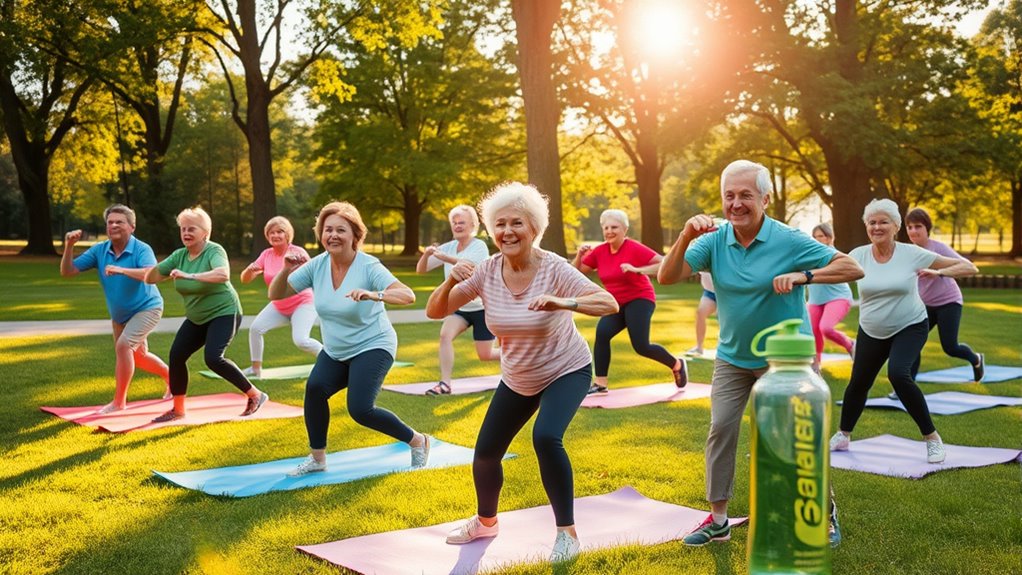
Incorporating breathing techniques into your exercise routine sets a strong foundation for achieving consistency in fitness.
When you commit to regular exercise, you’ll notice remarkable benefits:
- Improved Muscle Strength: A consistent routine can enhance your muscle strength, making daily tasks easier.
- Better Balance: Engaging in exercises three times a week reduces the risk of falls and supports independence.
- Enhanced Mood: Regular activity boosts your emotional well-being, decreasing anxiety and elevating your mood.
- Increased Mobility: Consistent stretching can improve your range of motion by up to 30%, enriching your overall quality of life.
Celebrating Progress and Community Support
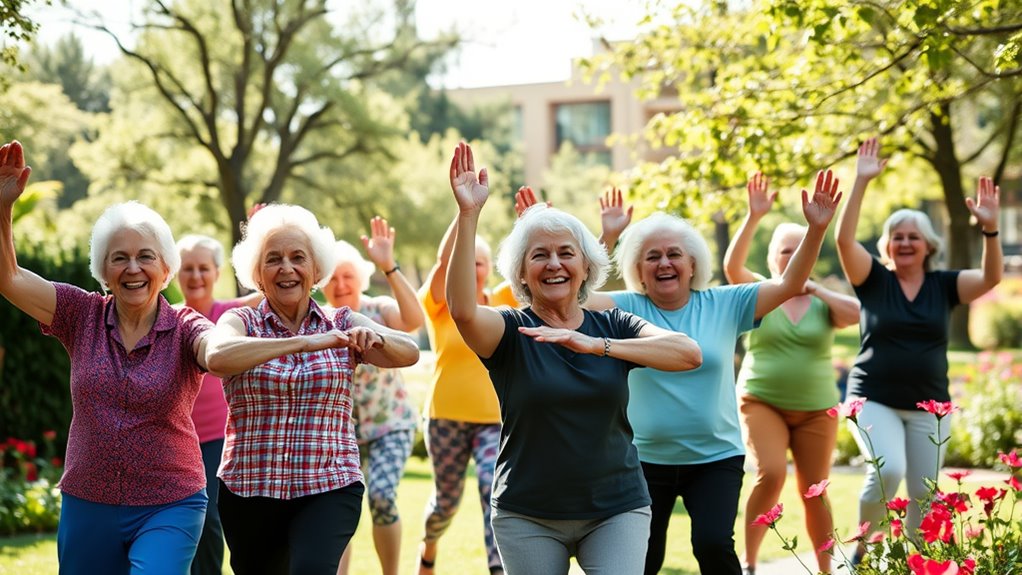
While initiating a fitness journey can feel intimidating, celebrating your progress and engaging with community support can make all the difference. Joining programs like Go4Life not only boosts motivation but also fosters friendships that combat loneliness. Recognizing your achievements, no matter how small, builds confidence and encourages you to set new fitness goals. Sharing experiences within a supportive community enhances learning and promotes collective growth.
Here’s a quick glance at the benefits of community exercise programs:
| Progress | Community Support | Health Outcomes |
|---|---|---|
| Increased confidence | Friendship and camaraderie | Improved strength |
| Motivation | Reduced isolation | Greater flexibility |
| Accountability | Enhanced social interaction | Better balance |
| Personal growth | Shared challenges | Overall well-being |
| Celebration | Encouragement | Active lifestyle |
Frequently Asked Questions
What Is the Number One Exercise for Seniors?
The number one exercise for seniors is strength training. By incorporating resistance exercises like arm curls and chair stands into your routine, you can build muscle mass, improve bone density, and enhance your overall functional fitness.
This helps you perform daily activities with ease. Aim for strength training at least twice a week, and don’t forget to add flexibility and balance exercises to reduce the risk of falls and boost your confidence!
What Is the Number 1 Exercise to Increase Balance in Seniors?
The number one exercise to increase balance in seniors is the single-leg stand.
You can practice this by lifting one leg and holding the position for 10-15 seconds.
Don’t worry if it’s challenging at first; you can use a sturdy chair or countertop for support.
Try to do this a few times daily, and consider adding variations like closing your eyes or moving your arms to further enhance your balance and stability.
What Is the AARP #1 Exercise for Seniors?
The AARP identifies walking as the #1 exercise for seniors. It’s accessible, low-impact, and boosts your cardiovascular health.
By incorporating just 30 minutes of walking into your routine most days, you can enhance your mobility, balance, and endurance.
Plus, walking can lower your risk of chronic diseases and improve your mental health. You can easily adjust the intensity and duration to match your fitness level, making it a perfect choice for staying active.
What Exercise Should a 70 Year Old Do Every Day?
Every day, you should focus on a mix of flexibility and balance exercises.
Start with gentle stretching to maintain your mobility, followed by balance activities like side leg raises. Aim for at least 10-15 minutes of these exercises daily.
They’ll help you stay stable and reduce the risk of falls. Remember to listen to your body, adjust as needed, and stay hydrated to keep your workouts effective and enjoyable.
Conclusion
As you lace up your sneakers, think of them as wings that empower you to soar through each exercise. Embracing a senior exercise program is like planting seeds in a garden; with time, patience, and care, you’ll bloom into your strongest self. Remember, every step you take not only builds your body but also nurtures your spirit. Celebrate each achievement, no matter how small, and let the support of your community be the sunlight that helps you grow.


